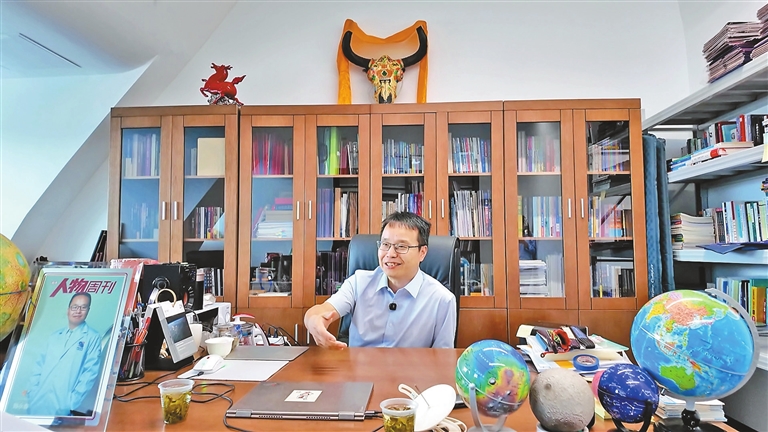
Windy Shao windysjf@hotmail.com WHEN it comes to science communication in China, Prof. Zheng Yongchun is a high-profile figure affectionately known as “Uncle Mars” for his contributions to popularizing astronomy for young audiences. Now director of the Shenzhen Science & Technology Museum, one of China’s major science museums, he continues to chart new paths in science communication and science education. His journey to the museum, from laboratory researcher to best-selling popular science author and public educator, raises a key question: how does he navigate the challenges of that transformation? Communicator, prolific author Zheng started writing popular science articles about 10 years ago while working as a planetary scientist at the National Astronomical Observatories of China (NAOC), driven by the public’s limited knowledge of topics like Pluto. “I initially wrote one or two articles on ScienceNet.cn, a platform where Chinese scientists share blogs, and my writing was purely driven by interest,” he told Shenzhen Daily during a recent interview. He soon found readers eagerly engaging. “Every time my post was featured, I got comments. That encouraged me to continue writing.” Reader feedback was invaluable. “Because the platform allowed me to edit, it felt like the internet was revising my manuscripts with me.” That interaction led to a series of accessible astronomy articles that became “Pluto Flyby,” his first popular science book. “My advice has always been to follow your interests,” Zheng emphasized. Fueled by passion and persistence, he has authored or co-authored over 20 popular science books. He has visited almost all provinces in China and more than 500 schools and museums nationwide, trained nearly 10,000 science teachers, and reached millions of teens through science lectures. His professional work and public outreach earned him the 2016 Carl Sagan Medal from the American Astronomical Society for his outstanding contributions to planetary science research and science communication. Zheng was the first Chinese scientist to receive this honor. Reflecting on this honor, he said, “Receiving the medal was a serendipitous honor. Many things in life aren’t pursued with deliberate intent.” For Zheng, effective science communication requires subject expertise. “Being able to write good science articles shows you have a deep understanding of the subject — you know how to simplify complex concepts and make profound ideas accessible,” he shared. ‘Leveling up’ as a science museum director Seven months ago, Zheng made a pivotal career move. After 21 years at the National Astronomical Observatories of China, he headed to Shenzhen to participate in establishing the Shenzhen Science & Technology Museum. “It’s been seven months since I moved from Beijing — I haven’t returned home once, though my wife and son remain there.” “It’s honestly a huge challenge,” Zheng said, comparing his new role to leveling up in a game. “Every day, you face different ‘monsters’ — new problems to tackle.” Zheng estimates that the science museum involves hundreds of organizations and over 1,000 collaborators. “The science museum is a grand integration of science, technology, education, and culture — a convergence of collective wisdom,” he told Shenzhen Daily. A museum with ‘Shenzhen DNA’ Zheng is focused on embedding what he calls “Shenzhen DNA” in the new museum. “Since this is a science museum in Shenzhen, a city synonymous with innovation, it must showcase Shenzhen’s science, technology, education, and innovation,” he explained. To achieve this, the museum features breakthroughs from local tech giants like Huawei, Tencent, and DJI. Zheng envisions the museum as a multidimensional hub — “A classroom for students, a showcase of tech companies, a forum for scientists, and a lifelong learning space for the public.” Accessibility for international visitors is also a key focus, leading to all exhibits and multimedia being bilingual. The museum’s theme — Digital Civilization · Innovation · Future — expresses a global view. “It’s a shared human story, from agricultural to industrial to digital civilization, all driven by innovation toward a common future,” he said. Zheng, who believes that an interdisciplinary approach will define the future of science museums, explained that the museum has taken a novel approach to designing its exhibits. “Most science centers worldwide group exhibits by discipline — physics, chemistry, biology. We organize our exhibits around cutting-edge technologies that impact daily life — from biomedicine, new materials, and clean energy to marine technology, space exploration, cosmic origins, and quantum science,” Zheng noted, adding that “we’ll export our exhibition ideas internationally.” Whether lecturing at schools or designing immersive exhibits, he is guided by one conviction. “Today’s youth are tomorrow’s innovators. We must nurture their scientific curiosity.” To Zheng, science communication isn’t just transferring knowledge — it’s cultivating scientific thinking and problem-solving skills. “Innovation doesn’t emerge from a vacuum — it requires fertile ground.” | 
